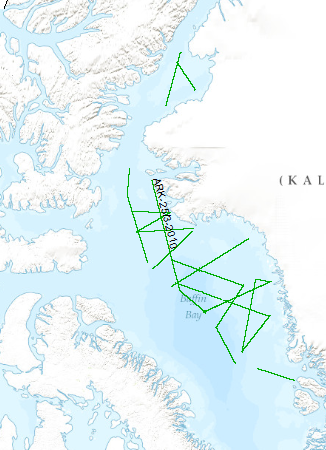The multidisciplinary marine geoscientific expedition ARK-25/3 was focused on the Greenland part of northern Baffin Bay and was aimed to acquire new geoscientific data to be used for modelling the evolution of the Greenland continental margin and its hydrocarbon prospective. The data format is Society of Exploration Geophysicists SEG Y. The cruise was performed under the direction of the Federal Institute for Geosciences and Natural Resources Hannover in cooperation with the Alfred-Wegener-Institute for Polar and Marine Research, Bremerhaven. Using 70 days of ship time onboard the research icebreaker R/V POLARSTERN a comprehensive data set was acquired along profiles extending from the deep oceanic basin in the central part of North Baffin Bay onto the Greenland continental margin in an area which was bordered by the Kane Basin in the North and Disko Island in the South. By means of multi-channel seismic, wide angle seismic, gravimetric and magnetic methods the structural inventory of the crust in the NW Baffin Bay was investigated. Additionally, heat flow data and sediment cores were collected along lines crossing the Greenland continental margin. The cores were extracted for geochemical and geomicrobiological analysis to be used for basin modelling, studying the hydrocarbon potential, and the hydrocarbon degradation by microorganisms under polar conditions. Geological sampling in the coastal area was done between Melville Bay and Washington Land. The collected rock material will be used to derive constraints on the erosion history of the coastal area. Aeromagnetic data was acquired covering a substantial part of the marine survey area to investigate magnetic signatures of the oceanic crust and the continental margin. This report summarizes the working programme and contains the documentation of acquired data and first results of the expedition. Die Forschungsfahrt ARK-25/3 führte in den grönländischen Teil der nördlichen Baffinbay. Schwerpunkt des wissenschaftlichen Programms bildeten multidisziplinäre marine Forschungs-arbeiten zur Klärung der tektonischen Entwicklung des grönländischen Teils der Baffinbay und der Abschätzung seines Kohlenwasserstoffpotentials. Die Daten liegen im Format der Society of Exploration Geophysicists SEG Y vor.Das Projekt wurde unter Federführung der Bundesanstalt für Geowissenschaften und Rohstoffe Hannover in Kooperation mit dem Alfred-Wegener-Institut Bremerhaven durchgeführt. Während der 70-tägigen Forschungsfahrt an Bord des F/S POLARSTERN wurde ein umfangreicher Datensatz entlang von Messprofilen akquiriert, die den Bereich vom Zentralteil der nördlichen Baffinbay bis auf den grönländischen Kontinentrand und von Disko Island im Süden bis zum Kane Basin im Norden abdecken. Mit Hilfe von Mehrkanalseismik, Weitwinkelseismik, gravimetrischen und magnetischen Messverfahren wurde das strukturelle Inventar der Kruste in der nordwestlichen Baffinbay untersucht. Zusätzlich wurden an mehr als 30 ausgewählten Lokationen entlang von Profilen über den grönländischen Kontinentrand Wärmestrommessungen vorgenommen und Sedimentkerne entnommen. Das Probenmaterial wird nachfolgend geochemisch und geomikrobiologisch analysiert. Die Ergebnisse fließen in Modellierungen der Beckenbildungsprozesse ein und werden für die Bewertung des Kohlenwasserstoffpotentials der Region und der Kohlenwasserstoffzersetzung durch Mikroorganismen unter polaren Bedingungen verwendet. Geologische Beprobungen von Aufschlüssen der küstennahen Region zwischen Melville Bay und Washington Land wurden vorgenommen, um die Erosionsgeschichte des grönländischen Kontinentrandes zu rekonstruieren. Aeromagnetische Befliegungen in weiten Teilen des Arbeitsgebietes flankierten das marine Arbeitsprogramm zur Untersuchung magnetischer Signaturen der ozeanischen Kruste und des grönländischen Kontinentrandes. Im vorliegenden Bericht werden Arbeitsprogramm und erste Ergebnisse der Forschungsfahrt dokumentiert.





